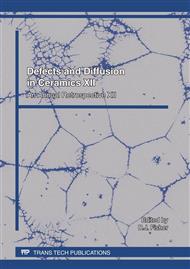[1]
Tanasawa, I. and Lior, N., Heat and Mass Transfer in Materials Processing, Hemisphere, Washington, D.C. (1992).
Google Scholar
[2]
Viskanta, R. and Bergman, T. L., Heat Transfer in Materials Processing, in Handbook of Heat Transfer, Chap. 18, McGraw-Hill, New York. (1998).
Google Scholar
[3]
Shuja, S. Z., Yilbas, B. S., and Budair, M. O.: Modeling of Laser Heating of Solid Substance Including Assisting Gas Impingement, Numer. Heat Transfer A, 33 (1998) 315.
DOI: 10.1080/10407789808913941
Google Scholar
[4]
Bianco, N., Manca, O. and Nardini, S., 2001, Comparison between Thermal Conductive Models for Moving Heat Sources in Material Processing, ASME HTD, 369-6, pp.11-22.
DOI: 10.1115/imece2001/htd-24331
Google Scholar
[5]
Rosenthal, D.: Mathematical Theory of Heat Distribution During Welding and Cutting, Welding Journal, 20.
Google Scholar
[5]
(1941) 220.
Google Scholar
[6]
Rykalin, N.N., and Nikolaev, A.V., Welding Arc Heat Flow, Welding in World, 9[3-4], (1971) 112.
Google Scholar
[7]
Malmuth N.D., Hall W.F., Davis B.I., and Rosen C.D., Transent Thermal Phenomena and Weld Geometry in GTAW, Welding Journal, 53.
Google Scholar
[9]
(1974) 388.
Google Scholar
[8]
Grosh R.J., Trabant E.A., Arc Welding Temperature, Welding Journal, 35.
Google Scholar
[3]
(1956) 396.
Google Scholar
[9]
Lin, M.L., Influence of Surface Depression and Convection on Weld Pool Geometry, Maters Thesis, MIT, Cambridge, MA, (1982).
Google Scholar
[10]
Nestor, O.H., Heat Intensity and Current Density Distribution at Anode of High Current Inert Gas Arcs, Journal of Applied Physics, 33.
DOI: 10.1063/1.1728803
Google Scholar
[50]
(1967) 1638.
Google Scholar
[11]
Eager, T. W., and Tsai, N. S.: Temperature Fields Produced by Traveling Distributed Heat Sources, Welding Journal, 62.
Google Scholar
[12]
(1983) 346.
Google Scholar
[12]
Jeong, S. K., and Cho, H. S.: An Analytical Solution to Predict the Transient Temperature Distribution in Fillet Arc Welds. Welding Journal, 76.
Google Scholar
[6]
(1997) 223.
Google Scholar
[13]
Goldak, J., Chakravarti, A., and Bibby, M. 1985. A Double Ellipsoid Finite Element Model for Welding Heat Sources, IIW Doc. No. 212, 603-85.
Google Scholar
[14]
Nguyen N.T., Ohta,A., Suzuki,N., Maeda,Y., Analytical Solutions for Transient Temperature of Semi-Infinite Body Subjected to 3-D Moving Heat Source, Welding Journal, August 1999, 265.
Google Scholar
[15]
Painter, M. J., Davies, M. H., Batters by, S., Jarvis, L., and Wahab, M. A. 1996. A Literature Review on Numerical Modeling the Gas Metal Arc Welding Process. Australian Welding Research, CRC. No. 15, Welding Technology.
Google Scholar
[16]
Pillai,K. R, Ghosh,A., Chattopadhyaya,S., Sarkar P.K.: Some Investigations of the Interaction of the Process Parameters of Submerged Arc Welding, Manufacturing Technology & Research, 3[1-2] (2007).
Google Scholar
[17]
Gunaraj, G., Murugan, N., Prediction of Heat-Affected Zone Characteristics in Submerged Arc Welding of Structural Steel Pipes, Welding Research, January 2002, 94.
Google Scholar
[18]
Wang, Y., Tsai, H.L., Impingement of Filler Droplets and Weld Pool Dynamics During Gas Metal Welding Process, International Journal of Heat and Mass Transfer, 44.
DOI: 10.1016/s0017-9310(00)00252-0
Google Scholar
[11]
(2001) (2067).
Google Scholar
[19]
Carraugo et al. Microstructural Change in High Temperature Heat-Affected Zone of Low Carbon Weldable 13% Cr, Martensitic Stainless Steels, Stainless Steel World, October 2002, 16.
Google Scholar
[20]
Murugan, N., Gunaraj, V., Prediction of Heat-Affected Zone Characteristics in Submerged Arc Welding of Structural Steel Plates, Welding Research, January, (2002), 94.
Google Scholar
[21]
Dutta, P., Weld Pool Dynamics during Submerged Arc Welding Process, North Bengal University Review (Science & Technology), 9.
Google Scholar
[1]
(1997) 83.
Google Scholar
[22]
Sreedhar, U., Krishnamurthy, C.V., Balasubramaniam, K., Raghupathy, V.D. and Ravishankar, S., Modeling and Simulation for Temperature Prediction in Welding Using Infrared Thermography, Proceedings of the National Seminar & Exhibition on Non-Destructive Evaluation, NDE 2009, December 10-12 (2009).
Google Scholar
[23]
Goldak, J.A., Akhlaghi, M., Computational Welding Mechanics, Springer, p.31.
Google Scholar
[24]
Kumar, A., Deb Roy, T., Calculation of Three-Dimensional Electromagnetic Force Field During Arc Welding, Journal of Applied Physics, 94.
Google Scholar
[2]
(2003) 1267.
Google Scholar


